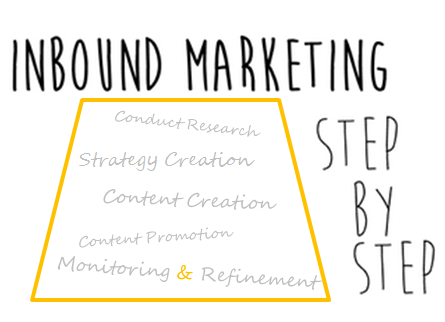
What’s involved in inbound marketing? What is the process, stage by stage?
If you’ve ever asked these questions, you’re not alone. So much is said about inbound marketing, but it’s not often enough we get down to the nitty-gritty about what’s actually done throughout the campaign. Though there may be dozens, if not hundreds of micro-tasks along the way, at its heart, inbound marketing consists of just five key steps:
1. Conduct Research
The first step is really all about gathering intel about three key areas:
- Your business. Time will need to be invested by both the agency and your business in interviews and questionnaires to learn as much about your company, mission, vision and values as possible. In addition to understanding who your business is, research is also done into your existing processes: Do you use a CRM? What are your approval processes like? Who are your stakeholders, and how will they be involved? What do your internal resources look like? All of this helps in creating a plan custom-tailored to your situation.
- Your customers. This is the stage at which personas are drawn up and key questions are asked about the people you’re trying to reach. Data must be gathered and analyzed in order to draw insights on the demographics, psychographics and buying cycles of the people you want to buy from you.
- Your competition. Understanding the playing field is critical for differentiation, but will also help illuminate what must be done and how long it might take to see results.
At this stage, a content audit will likely be conducted in order to identify what content has been successful in the past, and where there are gaps that need to be filled.
2. Create a Strategy
With all the data collected and analyzed, it’s time to formulate a plan of attack. Key to this step is documentation: Your strategy must be written down so that it can be articulated to anyone in the business with ease.
Because so many different groups will often be involved (stakeholders, owners, managers, content creators, the agency, etc.) it’s incredibly important to have reference documentation, including:
- An editorial calendar that defines what will be created, when and by whom
- A style guide that dictates what the company’s voice and tone will be and provides boundaries for content creation
- A list of specific and measurable goals and benchmarks with which to measure your success against
- A detailed content promotion plan, taking into account the assets available to the business (paid, owned and earned media)
This is also the stage where success is defined, goals are refined and key performance indicators are chosen.
3. Content Creation
With your strategy defined and your plans drawn, it’s time to create! At this stage, sourcing talented writers, designers, programmers and so on is the top priority. Throughout the creation process, checks and balances are put in place to ensure quality and that your branding is protected and consistent.
Creation can be done a number of ways – in house, through freelancers, through the agency and so on. Also as part of the creation process is often ideation for future topics and content pieces.
4. Content Promotion
Though content creation tends to get the bulk of the fanfare, the truth is, without promotion your content isn’t going anywhere. Content promotion is a critical stage worth investing serious time, effort and planning into; it will define the success you’re able to achieve.
In 2014, you can’t just wait and hope people will stumble across your content and come to you.
Promotion should take into account the three media available to the business:
- Paid media: Using paid promotion and sponsorships to get your content in front of the right eyeballs – especially useful in the early stages where your audience is small and scattered
- Owned media: Using your own social media channels and marketing channels (e-newsletters, blogs, etc.) to promote your content pieces. This is the easiest channel to use, but often the least effective until you’ve reached a critical mass of followers and fans.
- Earned media: The hardest to acquire – and the most powerful – earned media is unsolicited, voluntary sharing of your content by people who love it. This is the golden ticket for inbound marketing, but it can take a lot of time to develop.
Using these channels and the personas you’ve created, hubs and influencers will be targeted who can help expand your reach and bring in the right kinds of traffic.
5. Monitoring & Refinement
Measuring the impact of your work is critical to do – not once or twice or even quarterly, but ongoing. Throughout the campaign, you’ll want to monitor the successes of your content pieces relative to one another; the number and quality of leads generated, the links earned and other critical metrics that will let you know that the campaign is paying off.
As you gather more information and learn more about what’s gone right and wrong, you can use this data to refine and improve the strategy you’ve set out. Inbound marketing is a living, changing thing that can grow and evolve as you continue.
Not so difficult – but you do need to get started!
As you’ve read, inbound marketing itself isn’t rocket science – just methodical, conversational marketing taken online. As you gain an understanding of the different stages involved, it’s time to ask whether or not you’ve given each stage it’s fair time and energy – or whether you’ve even started.
If you haven’t – now is the time.